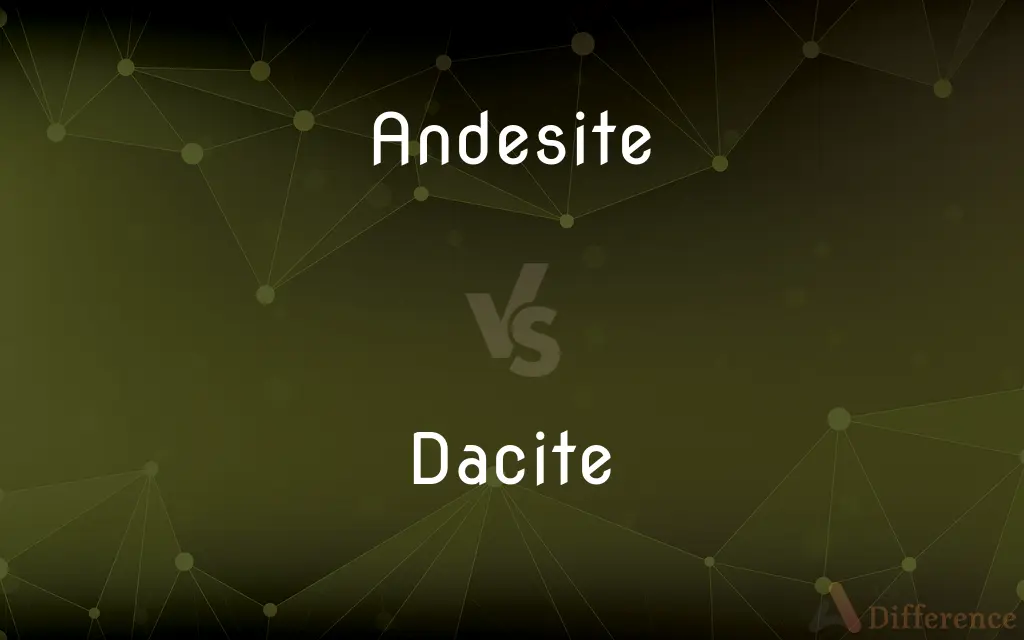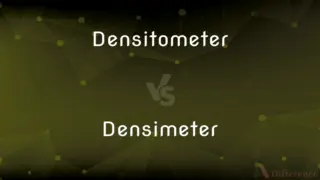Andesite vs. Dacite — What's the Difference?
By Fiza Rafique & Urooj Arif — Updated on April 15, 2024
Andesite and dacite are both volcanic rocks; andesite has a lower silica content compared to the higher silica content in dacite, influencing their textures and eruption styles.

Difference Between Andesite and Dacite
Table of Contents
ADVERTISEMENT
Key Differences
Andesite is a volcanic rock characterized by intermediate silica content, typically forming in volcanic arcs associated with subduction zones. Conversely, dacite contains a higher silica content, which gives it a more viscous texture and generally leads to more explosive volcanic eruptions.
In terms of mineral composition, andesite is typically rich in plagioclase with possible biotite, pyroxene, and amphibole. Dacite, on the other hand, also contains plagioclase but with a greater presence of quartz, which contributes to its higher silica content and differentiates it from andesite.
The texture of andesite can range from aphanitic to porphyritic, where smaller crystals are embedded in a fine-grained matrix. Dacite, however, tends to have a more visibly crystalline texture due to the slower cooling of its magma, which allows larger crystals to form.
Color variations between these two rocks also reflect their mineralogical differences; andesite usually appears as shades of gray or brown. In contrast, dacite often has a lighter color, typically light gray, due to its higher quartz content.
Geologically, andesite is often found in island arcs and continental margins, where oceanic plates subduct beneath continental plates. Dacite tends to occur in similar settings but is less common and usually associated with thicker continental crust and older subduction zones.
ADVERTISEMENT
Comparison Chart
Silica Content
Intermediate (52-63%)
High (63-69%)
Mineral Composition
Plagioclase, biotite, pyroxene, amphibole
Plagioclase, quartz, biotite, amphibole
Texture
Aphanitic to porphyritic
Predominantly porphyritic
Color
Gray, brown
Light gray, often lighter than andesite
Typical Occurrence
Volcanic arcs, subduction zones
Thicker continental crust, older subduction zones
Compare with Definitions
Andesite
A fine-grained, volcanic rock with intermediate silica content.
The ancient city was built on a foundation of andesite.
Dacite
A volcanic rock higher in silica and more viscous than andesite.
Dacite flows are typically slower due to their high viscosity.
Andesite
May show a porphyritic texture.
The andesite rock displayed large olivine crystals in a fine-grained matrix.
Dacite
Common in explosive volcanic settings.
The dacite dome was formed after a series of explosive eruptions.
Andesite
Often gray or brown in color.
The andesite samples varied from dark gray to brownish hues.
Dacite
Contains a noticeable amount of quartz.
The dacite's shiny quartz crystals were easily visible.
Andesite
Commonly found in island arc systems.
Andesite lava flows dominate the volcanic landscape of the island.
Dacite
Usually lighter in color, often light gray.
The exposed dacite was predominantly light gray with a slight pinkish tint.
Andesite
Associated with moderate to explosive eruptions.
The volcano's andesite composition suggested potential for explosive activity.
Dacite
Found in environments with thick continental crust.
Dacite deposits are common in the region's extensive continental crust.
Andesite
Andesite () is a volcanic rock of intermediate composition. In a general sense, it is the intermediate type between silica-poor basalt and silica-rich rhyolite.
Dacite
Dacite () is a volcanic rock formed by rapid solidification of lava that is high in silica and low in alkali metal oxides. It has a fine-grained (aphanitic) to porphyritic texture and is intermediate in composition between andesite and rhyolite.
Andesite
A gray, fine-grained volcanic rock consisting chiefly of plagioclase feldspar and one or more mafic minerals.
Dacite
A fine-grained light gray volcanic rock consisting primarily of quartz, plagioclase feldspar, and potassium feldspar, and also containing biotite, hornblende, or pyroxene.
Andesite
(geology) Any of a class of fine-grained intermediate igneous rock, of volcanic origin, containing mostly plagioclase feldspar.
Dacite
(geology) An igneous, volcanic rock with a high iron content.
Andesite
An eruptive rock allied to trachyte, consisting essentially of a triclinic feldspar, with pyroxene, hornblende, or hypersthene.
Dacite
A gray volcanic rock containing plagioclase and quartz and other crystalline minerals
Andesite
A dark gray volcanic rock
Common Curiosities
What is andesite?
Andesite is a fine-grained volcanic rock with an intermediate silica content.
What are typical minerals found in andesite and dacite?
Andesite typically contains plagioclase, biotite, and pyroxenes, while dacite includes these plus a greater amount of quartz.
Where are andesite and dacite typically found?
Both are typically found in volcanic arcs and subduction zones, but dacite is also associated with thicker continental crust.
Can the presence of quartz in dacite affect its properties?
Yes, quartz increases the silica content and viscosity, making dacite more prone to explosive volcanic eruptions.
What is dacite?
Dacite is a volcanic rock that is similar to andesite but contains a higher percentage of silica.
Why is dacite less common than andesite?
Dacite forms in more specific geological settings, often requiring thicker continental crust and older subduction zones, making it less common than andesite.
How does the silica content of andesite compare to dacite?
Andesite has a lower silica content (52-63%) compared to dacite (63-69%).
What are the eruption styles of andesite and dacite volcanoes?
Andesite volcanoes can have moderate to explosive eruptions, while dacite eruptions are generally more explosive due to higher silica content.
What causes the color differences between andesite and dacite?
The color difference is mainly due to their mineral compositions; dacite contains more quartz, giving it a lighter color.
How do the textures of andesite and dacite differ?
Andesite may have an aphanitic to porphyritic texture, while dacite typically shows a more pronounced porphyritic texture with larger crystals.
Share Your Discovery

Previous Comparison
Densitometer vs. Densimeter
Next Comparison
Porridge vs. RisottoAuthor Spotlight
Written by
Fiza RafiqueFiza Rafique is a skilled content writer at AskDifference.com, where she meticulously refines and enhances written pieces. Drawing from her vast editorial expertise, Fiza ensures clarity, accuracy, and precision in every article. Passionate about language, she continually seeks to elevate the quality of content for readers worldwide.
Co-written by
Urooj ArifUrooj is a skilled content writer at Ask Difference, known for her exceptional ability to simplify complex topics into engaging and informative content. With a passion for research and a flair for clear, concise writing, she consistently delivers articles that resonate with our diverse audience.
















































